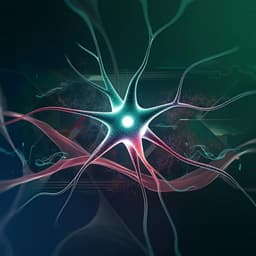
Health and Fitness
Exercise intervention in middle-aged and elderly individuals with insomnia improves sleep and restores connectivity in the motor network
R. Chen, S. Wang, et al.
This groundbreaking study by Rongrong Chen and colleagues reveals that a 12-week exercise program significantly enhances sleep quality and boosts brain functional connectivity in older adults suffering from insomnia. Discover how this intervention not only improves sleep but also promotes functional plasticity in the aging brain.
~3 min • Beginner • English
Introduction
Insomnia is the most common sleep disorder and highly prevalent among older adults, characterized by difficulties initiating or maintaining sleep, early-morning awakening, and associated daytime impairment. Existing treatments (psychological/behavioral therapies and pharmacological interventions) have limitations in efficacy, side effects, and cost, motivating exploration of alternative approaches. Exercise has been recognized as a potential treatment that can improve sleep quality, efficiency, duration, latency, and disturbances. Aerobic and resistance exercises, including Tai Chi, have shown benefits in older populations. Combining Tai Chi with resistance training may enhance physical function and sleep beyond either modality alone.
Animal and human studies indicate that exercise induces morphological and functional brain changes, including in motor cortex, cerebellum, striatum, hippocampus, and prefrontal regions. However, the functional connectivity (FC) changes underlying exercise-induced sleep improvements in middle-aged and older adults with insomnia remain unclear. Resting-state FC can serve as biomarkers or therapeutic targets for insomnia.
This study first compared middle-aged and older adults with insomnia against healthy sleepers to characterize neurobiological mechanisms using resting-state fMRI, focusing on the motor network (M1 seed-based whole-brain FC). The study then tested whether a 12-week combined Tai Chi plus resistance training program improves subjective and objective sleep quality and restores motor network FC in insomnia participants, and whether FC changes track symptom improvements. We hypothesized that exercise would improve sleep measures versus waitlist control, that motor network FC would recover after exercise, and that FC changes would correlate with sleep improvement.
Literature Review
Methodology
Design and registration: Nonrandomized controlled trial adhering to TREND guidelines; registered on ChiCTR (ChiCTR2000033652). Ethics approval from Peking University (2019-03-07). Written informed consent obtained.
Participants: Recruited via community advertisements around Peking University. Inclusion: Chinese, right-handed, age 45–80, MMSE > 25. Insomnia group met DSM-5 insomnia disorder criteria; healthy controls (HCs) reported satisfactory sleep. Exclusion: history of psychiatric/neurological illness; psychoactive substance abuse; serious medical conditions (liver, kidney, infectious, endocrine, cancer); shift work or recent trans-meridian travel (past 3 months); MRI contraindications; sleep-affecting drugs within 2 weeks.
Cohort: 85 insomnia recruits and 84 HCs completed baseline assessments. Insomnia participants were sequentially allocated to 12-week exercise (EX) or 12-week waitlist (WL). Thirty-seven EX and 30 WL completed baseline and week-12 assessments. HCs provided cross-sectional comparison.
Intervention: 12-week program, ~90 minutes per session, supervised by licensed instructors. Protocol integrated Tai Chi warm-up and routines (Huang Gong: Tai Chi Huang and Tai Chi Bai; Shen-style 8-form Tai Chi) plus resistance training (details in Supplementary Table S1). WL participants maintained usual activities without intervention.
Baseline and covariates: Collected demographics (age, sex, education), MMSE, BMI, medication/substance history, neurological/psychiatric history, and weekly physical activity (IPAQ).
Outcomes:
- Subjective sleep: Insomnia Severity Index (ISI), Pittsburgh Sleep Quality Index (PSQI). Emotional measures: Self-Rating Anxiety Scale (SAS), Self-Rating Depression Scale (SDS).
- Objective sleep: Wearable single-channel frontal EEG device (LumiSleep). Two-night recording (first night adaptation; second night for analysis; third night if data quality insufficient). Automated 30-s epoch staging (wake, light, deep, REM) with visual verification. Extracted total sleep time, stage durations/percentages, wake after sleep onset (WASO), and other indices.
MRI acquisition: 7T Siemens Prisma, 64-channel head coil. Resting-state BOLD EPI: TR = 2000 ms, TE = 30 ms, flip angle 90°, 33 slices, slice thickness 3.5 mm, gap 0.7 mm, matrix 64×64, in-plane resolution 3.5×3.5 mm², duration 480 s (240 volumes). Eyes open; camera monitoring to prevent sleep. T1-weighted MPRAGE: TR = 2530 ms, TE = 2.98 ms, TI = 1100 ms, FA = 7°, 192 slices, voxel 0.5×0.5×1 mm³.
fMRI preprocessing: AFNI and MATLAB. Steps: discard first 5 volumes; slice-timing and motion correction; spatial normalization to ICBM152 (voxel 2×2×2 mm³) using T1 segmentation; nuisance regression (24 motion parameters, mean white matter, CSF, whole-brain signals and first derivatives); linear detrend; bandpass 0.009–0.08 Hz; spatial smoothing 6-mm FWHM Gaussian kernel. Seed definition based on Automated Anatomical Labeling atlas. Seed-based FC: Pearson correlation between M1 seeds and all voxels; Fisher r-to-z transform.
Outcomes hierarchy: Primary—improvement in sleep efficiency and sleep quality (subjective and objective). Secondary—changes in motor network FC.
Statistical analysis: Group comparisons (insomnia vs HCs) of subjective and objective sleep via independent-samples t-tests (SPSS 26). Exercise effects assessed with paired t-tests within groups (baseline vs week 12) and group×time interactions; between-group differences at week 12 reported. FC differences (left and right M1) analyzed with mixed-model ANOVA controlling age, sex, years of education, brain volume, and head motion (translation mean, motion counts >1.5 mm, average framewise displacement). Multiple comparisons controlled using AFNI ACF-based cluster correction (voxelwise p < 0.001; cluster-corrected p < 0.05; minimum cluster size ≥20 voxels for left motor connectivity). Post hoc tests examined EX vs WL changes. Brain–behavior correlations in EX group between FC changes (week 12 – baseline) and sleep/emotion changes via Pearson correlation (MATLAB). Sensitivity analysis included SDS as covariate.
Key Findings
- Insomnia vs healthy controls: Insomnia participants had markedly worse self-reported sleep and higher negative affect. ISI difference = 14.17 (95% CI 13.23–15.12; P < 0.001); PSQI difference = 8.23 (95% CI 7.41–9.04; P < 0.001). Higher anxiety and depression (e.g., SAS difference = 14.15; P < 0.001; SDS higher, P < 0.001). Objective sleep showed longer wake after sleep onset (WASO difference = 19.38 min; 95% CI 2.01–45.96; P = 0.048) and longer REM sleep onset latency.
- Motor network alterations in insomnia: Relative to HCs, insomnia showed decreased connectivity across the motor network, including altered M1 coupling with cerebellum and superior parietal lobule.
- Primary outcomes (exercise effects on sleep): Significant group×time effects with improvements in EX but not WL.
• EX within-group improvements: ISI change −4.19 (95% CI −5.81 to −2.57; P < 0.001); PSQI change −3.49 (95% CI −4.51 to −2.46; P < 0.001). Negative emotion improved: SAS change −5.97 (95% CI −9.26 to −2.69; P < 0.001); SDS change −12.05 (95% CI −17.06 to −7.05; P < 0.001).
• Between-group (EX vs WL) at 12 weeks: ISI difference −3.36 (95% CI −5.56 to −1.16; P = 0.0027); PSQI difference −3.32 (95% CI −5.13 to −1.50; P < 0.001).
• Objective sleep: Exploratory analysis indicated shorter WASO after exercise, but the interaction was not statistically significant.
- Secondary outcomes (motor network FC): Exercise significantly increased/restored negative connectivity between left M1 and bilateral cerebellum relative to WL. EX within-group changes: left M1–right cerebellum FC Δz ≈ +0.14 (95% CI 0.09–0.19; P < 0.001); left M1–left cerebellum FC Δz ≈ +0.13 (95% CI 0.07–0.19; P < 0.001). WL showed no significant changes.
- Brain–behavior relationships: In EX, greater improvements in ISI correlated with larger FC changes within the primary motor network (r = −0.50, P = 0.002; r = −0.48, P = 0.003) and between right M1 and superior parietal lobule (r = 0.41, P = 0.011). Reduced anxiety (SAS) also associated with FC changes.
- Sensitivity analysis controlling for SDS: Group×time effects remained significant for ISI (p = 0.008), PSQI (p < 0.001), SAS (p = 0.009), and M1–cerebellum connectivity (p = 0.003 and p = 0.011). Correlations between ISI improvements and motor network FC changes remained significant (e.g., r = −0.53, p < 0.001; r = −0.46, p = 0.005), as did associations with right M1–superior parietal lobe (r = −0.44, p = 0.007) and SAS–FC links.
Discussion
This study demonstrates that middle-aged and older adults with insomnia exhibit impaired subjective and objective sleep and altered motor network connectivity compared to healthy sleepers. Implementing a 12-week combined Tai Chi and resistance training program improved subjective sleep quality (ISI, PSQI) and reduced negative affect (SAS, SDS) relative to a waitlist control. At the neural level, exercise enhanced motor network functional connectivity, particularly between M1 and cerebellum, indicating restoration of functional plasticity within circuits implicated in sleep regulation and motor control.
These findings address the central hypothesis that exercise benefits sleep in older adults with insomnia and that improvements are accompanied by functional reorganization of motor circuitry. The observed correlations between FC changes and ISI improvements suggest that motor network plasticity may be a mechanistic substrate linking exercise to sleep enhancement. Strengthened M1–cerebellar coupling could optimize sleep-related motor control and potentially modulate sleep oscillations, contributing to more consolidated sleep. The results align with literature showing exercise-induced brain plasticity and extend it to insomnia by highlighting motor network involvement.
Together, the results support exercise as a nonpharmacological strategy to improve sleep and emotional well-being in aging populations with insomnia, with resting-state FC offering candidate biomarkers to monitor or predict treatment response.
Conclusion
Middle-aged and older adults with insomnia show motor network hypoconnectivity and poorer sleep relative to healthy controls. A 12-week combined Tai Chi plus resistance training intervention improved subjective sleep quality and reduced negative affect, while restoring motor network connectivity—particularly M1–cerebellar coupling. FC changes tracked clinical improvements, supporting a mechanistic link between exercise-induced brain plasticity and sleep benefits. Future research should incorporate randomized controlled designs with active/sham controls, balanced baseline characteristics, longer follow-up to assess durability, and exploration of dose–response and modality-specific effects on both objective sleep architecture and neural circuits.
Limitations
- Control condition: Waitlist rather than an active/sham control limits causal inference and may not fully account for expectancy/placebo effects.
- Baseline imbalance: Higher baseline depression (SDS) scores in the exercise group introduce potential confounding, although sensitivity analyses controlling for SDS upheld main findings.
- Follow-up: No long-term post-intervention follow-up (e.g., 6–12 months) to assess durability of sleep and connectivity changes.
- Sample characteristics: Many participants were previously sedentary; sex ratio imbalanced (females overrepresented), which may limit generalizability.
- Objective sleep outcomes: Only exploratory improvements in WASO; limited significant changes in other objective sleep parameters within the 12-week timeframe.
Related Publications
Explore these studies to deepen your understanding of the subject.







